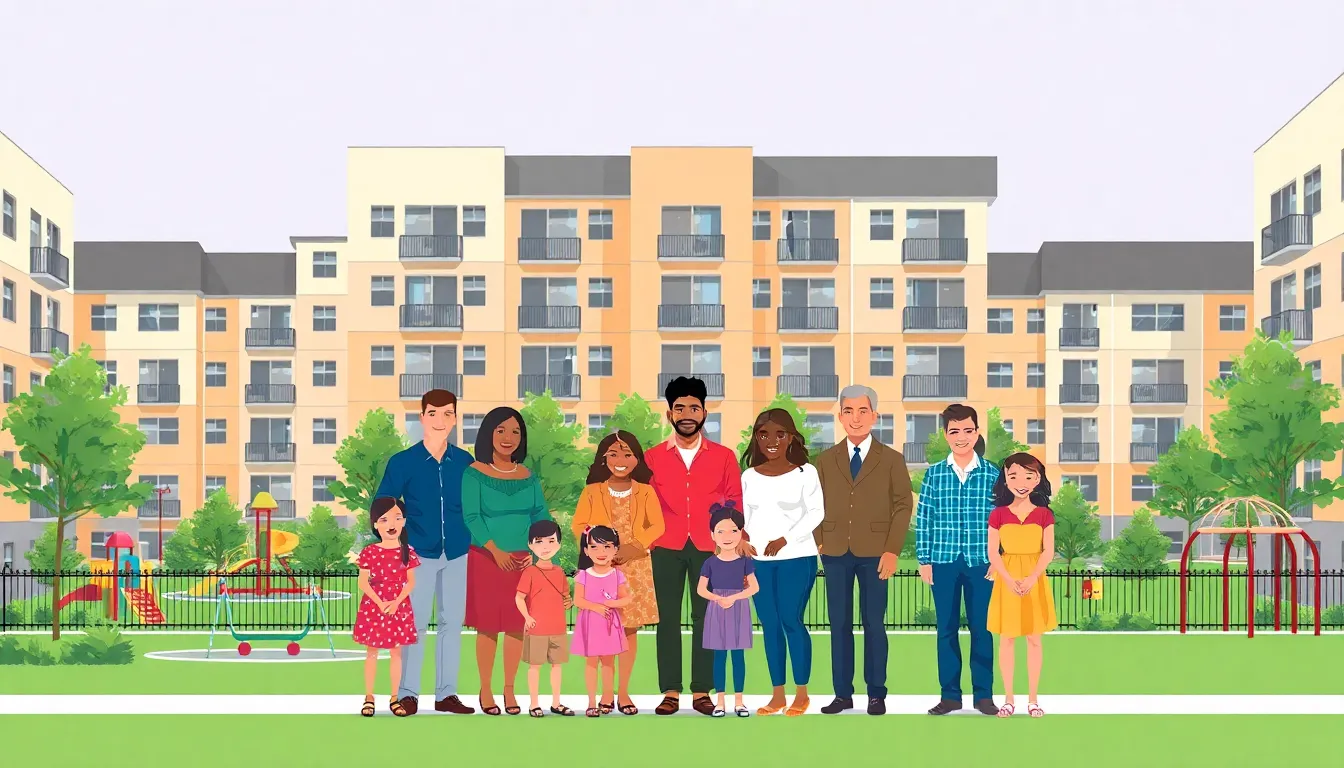Table of Contents
ToggleAffordable housing might sound like a unicorn in today’s real estate jungle, but it’s very much real and essential. Ever wondered how it works? It’s like a well-oiled machine, designed to ensure that everyone has a roof over their head without breaking the bank. With skyrocketing rents and housing prices, understanding this system could be the difference between living in a cozy home or a cardboard box.
Understanding Affordable Housing
Affordable housing refers to housing units that are affordable to those whose income is below the median. It often involves government programs that assist low- and moderate-income families to secure stable living conditions. These units might include rental apartments or homes bought at reduced prices due to subsidies.
Definition of Affordable Housing
Affordable housing meets specific income criteria to ensure that residents pay no more than 30% of their gross income on housing costs. The U.S. Department of Housing and Urban Development (HUD) defines this important measure. Such housing allows families to allocate resources to other essential needs, thereby promoting overall well-being. Additionally, programs like the Low-Income Housing Tax Credit (LIHTC) help create and maintain these affordable options.
Importance of Affordable Housing
Affordable housing plays a crucial role in combating homelessness and housing instability. It fosters community development by ensuring diverse neighborhoods. Creating affordable housing options advances economic mobility for low-income families and pressures rising rents. Enhanced access to quality education and health services often arises from stable housing situations. Housing affordability links directly to overall economic health, reflecting the need for continued investment in and support of these initiatives.
Types of Affordable Housing

Affordable housing encompasses various types designed to assist low- and moderate-income families. Understanding these types provides insight into how affordable housing operates efficiently.
Public Housing
Public housing consists of government-owned residential units managed by local housing authorities. These programs provide rental properties at reduced rates for eligible residents. Rent typically aligns with household income, ensuring affordability. Various locations across the United States offer public housing, helping millions secure stable living conditions. The U.S. Department of Housing and Urban Development oversees funding and regulations, enhancing the effectiveness of public housing initiatives.
Subsidized Housing
Subsidized housing indicates units that receive financial assistance from government programs to lower rents for tenants. Income-based rent adjustments occur, allowing families to pay no more than 30% of their income towards housing costs. This system includes several programs, such as Section 8 vouchers, which enable participants to rent privately-owned homes. Many communities support these initiatives, promoting mixed-income neighborhoods. Ultimately, subsidized housing plays a crucial role in meeting the diverse needs of families while reducing homelessness and housing instability.
Funding Mechanisms for Affordable Housing
Funding mechanisms play a critical role in fostering affordable housing. They ensure that low- and moderate-income families can access stable and affordable living conditions.
Government Grants and Subsidies
Government grants and subsidies serve as vital resources in the affordable housing landscape. These funds often come from federal, state, and local programs designed to support housing initiatives. Direct financial assistance helps developers lower construction costs or provide reduced rents for tenants. The U.S. Department of Housing and Urban Development administers several programs that allocate these resources. For instance, Community Development Block Grants (CDBG) offer flexible funding for various housing projects. Entities leveraging these grants can enhance local housing supply, ensuring broader access to affordable options for families.
Tax Credits for Developers
Tax credits represent another significant funding mechanism for affordable housing initiatives. These credits incentivize developers to construct or rehabilitate low-income housing units. The Low-Income Housing Tax Credit (LIHTC) program, established in 1986, has become a crucial tool in stimulating private investment for affordable housing. Developers claiming these tax credits typically commit to renting a certain percentage of units at below-market rates. This arrangement benefits both the developers by reducing tax liability and the community through increased affordable housing stock. It’s an essential strategy for promoting sustainable, mixed-income neighborhoods across the country.
Challenges in Affordable Housing
Affordable housing faces numerous challenges impacting its effectiveness and reach. These challenges hinder its ability to meet the growing demand and support vulnerable populations.
Limited Availability
Limited availability of affordable housing units significantly constrains options for low- and moderate-income families. Urban areas often experience a shortage, with demand far exceeding supply. Barriers such as high land costs and zoning regulations further limit the construction of new units. Developers frequently encounter obstacles that hinder their ability to create affordable housing. Many existing units face deterioration, leading to further depletion of affordable options. Market pressures continuously exacerbate this issue, worsening housing instability for marginalized groups.
Policy and Regulation Issues
Policy and regulation issues complicate the landscape of affordable housing. Local ordinances may impose restrictions that delay or prevent development. Funding mechanisms often lack sufficient resources to meet growing needs. Public policies also vary widely, contributing to inconsistencies in housing availability across regions. The complexity of navigating various financing options can deter potential developers. Additionally, bureaucratic processes can slow down project timelines, further stressing the system. Addressing these regulatory challenges remains crucial for enhancing affordable housing initiatives.
The Role of Non-Profit Organizations
Non-profit organizations play a vital role in the affordable housing sector, addressing the pressing needs of communities. They implement various community development initiatives aimed at improving living conditions for low- and moderate-income families.
Community Development Initiatives
Non-profits often lead efforts to revitalize neighborhoods through strategic planning and community engagement. They foster collaboration among local residents, government agencies, and businesses to create sustainable housing solutions. Events such as community workshops and forums allow residents to voice their needs, guiding project development. Affordable housing projects frequently include amenities like parks and community centers, enhancing residents’ overall living experiences. Through education and outreach programs, non-profits raise awareness about available housing options, empowering families to secure stable living situations.
Partnerships with Government
Partnerships with government entities significantly enhance the capacity of non-profits to deliver affordable housing solutions. Grants and funding from local, state, and federal agencies provide necessary resources for projects. Many non-profits collaborate with agencies like the U.S. Department of Housing and Urban Development to access financial assistance programs. These partnerships often lead to innovative housing models that combine income sources and resources. Joint efforts focus on streamlining regulatory processes and advocating for policy changes that support affordable housing initiatives. Engaging with government helps align non-profit goals with broader community development strategies.
Understanding how affordable housing works is essential for navigating today’s housing market. It plays a pivotal role in ensuring that low- and moderate-income families can secure stable living conditions without being financially overwhelmed. The various programs and initiatives in place not only address immediate housing needs but also promote long-term community development and economic mobility.
As challenges persist in the affordable housing sector, ongoing support and investment are crucial. By fostering collaboration among government agencies, non-profits, and communities, it’s possible to create innovative solutions that meet the diverse needs of families. A commitment to affordable housing is not just about providing shelter; it’s about building thriving communities where everyone has the opportunity to succeed.







